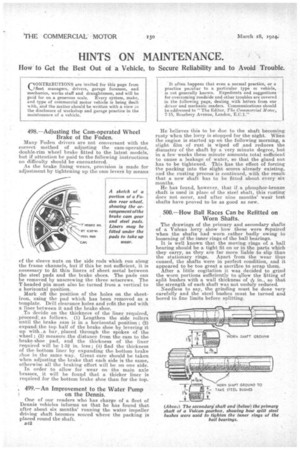HINTS ON MAINTENANCE.
Page 26

If you've noticed an error in this article please click here to report it so we can fix it.
How to Get the Best Out of a Vehicle, to Secure Reliability and to Avoid Trouble.
498.—Adjusting the Cam-operated Wheel Brake of the Foden.
Many Foden drivers are not conversant with the correct method of adjusting the earn-operated, double-rim wheel brake fitted to the latest models, but if attention be paid to the following instructions
no difficulty should be encountered. • As the brake lining wears, provision is made for adjustment by tightening up the cam lever S by means
of the sleeve nuts on the side rods which run along the frame channels, but if this be not sufficient, it is necessary to fit thin liners of sheet metal between the steel pads and the brake shoes. The pads can he removed by unscrewing the three setscrews. The T-headed pin must also be turned from a vertical to a horizontal position.
Mark off the position of the holes on the sheetiron, using the pad which has been removed as a template. Drill clearance holes and refit the pad with a liner between it and the brake shoe.
To decide on the thickness of the liner required, proceed:, as follows. (I) Lengthen the side rollers until the brake cam is in a horizontal position ; (2) expand, the top half of the brake shoe by levering it up with ,.a bar., placed through the spokes of the
• wheel;. (3) measure .the distance from the cam to the
• brake-shoe pad, and the thickness of the liner required will be 1-32 .in. less; (4) find the thickness of the bottom, liner by expanding the bottom brake shoe in the same way. Great care should be taken when adjusting the brake that each side is the same, otherwise all the braking effort will be on one side. In order to allow for wear on the main axle brasses, it will be found that a thicker liner is required for the bottom brake shoe than for the top.
, 499.—An Improvement to the Water Pump on the Dennis.
One of our readers who has charge of a fleet of Dennis vehicles informs us that he has found that after about six months' running the water impeller driving shaft becomes scored where the packing is placed round the shaft.
,B42 He believes this to be due to the shaft becoming rusty' when the lorry is stopped for the night. When ihe engine is started up on the following morning, a slight film of rust is wiped off and reduces the diameter of the shaft by a very minute degree, but in a few weeks these minute amounts .total sufficient to cause a leakage of water, so that the gland nut has to be tightened. This has the effect of forcing the packing into the slight scores already existing, and the rusting process is continued, with the result that a new shaft has to he fitted about every six months.
He has found, however, that if, a phosphor-bronze shaft is used in place of the steel shaft, this rusting does not occur, and after nine months' wear. test shafts have proved to be as good as new.
500.—How Ball Races Can be Refitted on Worn Shafts.
The drawings of the primary and secondary shafts of a Vulean lorry show how these were repaired when the shafts had worn rather badly owing to loosening of the inner rings of the ball bearings. It is well known that the moving rings of a ball bearing should be a tight fit on or in the parts which they carry, as they are far more liable to slip than the stationary rings. Apart from the wear thus caused, the shafts were in perfect condition, and it appeared to be too reat a sacrifice to scrap them.
After a little cogitation it was decided to grind the worn portions sufficiently to, allow the fitting of split hushes with a wall thickness of air, in., so that the strength of each shaft was not unduly reduced.
Needless to say, the grinding must be done very carefully and the steel bushes must be turned and bored to fine limits before splitting.




























